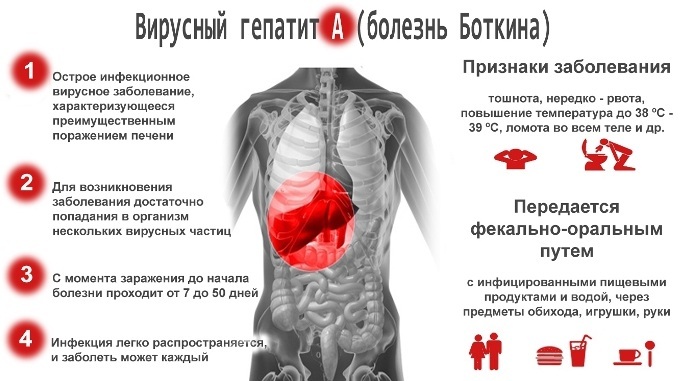Botkin's disease or hepatitis A is an acute infectious-viral pathology of the liver, which has a benign course. In another way, the disease is called intestinal infection. Most often hepatitis And it happens in autumn and winter. But you need to know whether the virus is transmitted from person to person, the symptoms of infection and methods of treatment.
Record content:
- 1 The reasons for the development of the disease
- 2 Risk factors
- 3 Is hepatitis A spread from person to person?
- 4 The incubation period of the disease
- 5 What is the danger of pathology?
- 6 Symptoms of pathology
-
7 Diagnostics
- 7.1 Laboratory research
- 7.2 Hardware diagnostics
-
8 Treatment of the disease
- 8.1 Medication
- 8.2 Folk remedies
- 8.3 Diet therapy
- 9 Prognosis and complications
- 10 Hepatitis A video
The reasons for the development of the disease
Hepatitis A (spread from person to person through close contact) can appear for a variety of reasons.
The most common ones are:
- visiting dirty reservoirs - the virus enters the oral cavity;
- the use of substandard or spoiled products;
- eating raw meat, fish, shellfish;
- buying contaminated vegetables;
- a person constantly uses water that has poor purification - the point concerns not only the use of liquid inside, but also washing hands or kitchen utensils;
- food preparation by a person who does not follow the rules of personal hygiene;
- the introduction of narcotic substances intravenously using a non-sterile syringe - the virus circulates in the blood and is transmitted from one person to another.

When a disease is transmitted to a person through a liquid, it is a waterway. This method is often found in autumn and spring, as well as when it rains constantly. Therefore, in regions with insufficient liquid purification, the disease is transmitted even to children.
If a person becomes infected by eating food, the route of transmission is called food. Most often, the virus stays in fish for a long time, or more precisely, in its gills. When a person prepares this product, careful heat treatment is required. And if snacks or salads are created, then you should adhere to the rules of personal hygiene.
Risk factors
There are factors that increase the likelihood of hepatitis A.
The disease can appear when exposed to the following points:
- neglect of personal hygiene;
- frequent stay in places with a large concentration of the population - kindergarten, school and more;
- living in inappropriate conditions - lack of sewerage and running water;
- trips to cities where hepatitis A is most common - the likelihood of transmission of the disease increases if there is no vaccination;
- living with an infected person;
- sexual contact with an infected person;
- intravenous injection of narcotic substances - the virus can be transmitted by using 1 syringe many times, or by neglecting personal hygiene;
- work in housing and communal services, a person is engaged in cleaning the sewage system.
Is hepatitis A spread from person to person?
Hepatitis A can be passed from an infected person to a healthy person.
There are several ways:
- Contact. The virus is transmitted by communicating with an infected person. But this only happens if the rules of patient care are violated. For example, in a nursing home or hospital. When in contact with a sexual partner, the pathogen is rarely transmitted, but such cases do happen. And if the couple is homosexual, the likelihood of infection increases. The same goes for anal intercourse.
- Placental. There are times when the virus is transmitted through the barrier from mother to fetus.
- Parenteral - This is the transmission of the virus from one person to another through the blood. Such cases happen with donation. The probability of transmission is low, since before the delivery of the biomaterial, people undergo a complete examination of the body. The modern multistage control system helps to minimize the transmission of the hepatitis A virus from an infected person to a healthy person through donated blood.
The incubation period of the disease
Hepatitis A (transmitted from person to person by the parenteral route) is a disease that has an incubation period. It lasts from the moment the virus enters the body until symptoms appear.
In another way, the phase is called latent. The average length of the period is from 14 to 28 days. But a duration of 7 to 50 days is allowed. During the incubation period, a person can infect other people, that is, the virus is transmitted.
The duration of the latent period depends on various factors:
- Conditions for the penetration of the virus. If a large number of infected cells enter the human body, an increased load appears. This happens when donated blood is transfused.
- Immunity work. At this point, you need to take into account the ability of the system to resist the virus.
- General well-being. If in a person's life there is frequent stress, lack of sleep or overwork, then the incubation period is shortened, the symptoms of the next phase will be noticeable earlier.
- Age category. In children, immunity is not fully developed. And in older people, the system works worse, since the functioning of many organs is disrupted. Therefore, these categories of people have a shorter incubation period.
What is the danger of pathology?
Hepatitis A is considered less dangerous than other types of the disease - B, C, D.
But pathology is often transmitted from person to person. First comes the incubation stage, which is asymptomatic. But at this time, a person can infect other people. The first symptoms are noticeable after at least 7 days.

Despite the fact that the disease is mild, the liver is heavily loaded. This can negatively affect the condition of other organs, and the likelihood of diseases increases.
The hepatitis A virus is dangerous because of its resistance to external conditions. At room temperature (20 to 28 degrees), the microorganism lives for 7 to 14 days. And in the freezer, it can exist for up to several years. In human feces, the virus lives up to 1 month.
If contaminated water is heated to a temperature of 60 degrees, the causative agent of the disease dies after 12 hours. And when the liquid is boiled, the vital activity of the virus does not exceed 5 minutes.
The microorganism is resistant to perchloric acid, alcohol, antiseptic solutions (Chlorhexidine, Miramistin, Hydrogen peroxide).
Since hepatitis A is dangerous, as a preventive measure it is necessary to adhere to certain rules:
- wash your hands before eating, after using the toilet or outside;
- each person in the family should have their own towel, toothbrush and other accessories;
- wash clothes at high temperatures;
- drink only purified water - it is recommended to purchase liquid in the store, additionally boil it;
- eat only thermally processed food;
- before eating fruits and vegetables, they must be thoroughly rinsed under water, and also poured over with boiling water;
- if there is an infected person in the house, the dishes should be disinfected and then boiled;
- if a person is at risk (work in kindergarten, etc.) or lives in an area where hepatitis A is common, you should consult your doctor about the vaccination.
Symptoms of pathology
The symptoms of hepatitis A depend on the phase of the disease. The incubation period is stage 1 of the disease. After it, hepatitis A is characterized by a prodromal or panicteric phase. Its duration is from 3 to 6 days. The person has signs of general malaise.
Among the primary symptoms of hepatitis A, there is an increase in body temperature up to 38 - 39 °, disturbances in the gastrointestinal tract (problems with stools, gas formation), lack of appetite. Additionally, there is nausea, vomiting, a bad odor from the oral cavity. A person is characterized by increased irritability, nervousness. The occurrence of a slight cough and a runny nose is allowed.
After a while, pain appears under the right rib. The symptom is similar to that of an intestinal infection. Loose stools appear and a bubbling in the abdomen. Additionally, there is pain in the head.
Since hepatitis A can be confused with SARS and intestinal infection, you need to know the distinctive signs. They are shown in the table.
| Index | Manifestation in hepatitis A | Manifestation with ARVI | Manifestation with intestinal infection |
| Dyspepsia - discomfort in the abdomen, difficult and painful digestion | Symptoms persist in the panicular and icteric stages. | When the body temperature drops to the optimal value, the symptoms diminish. | This condition is characterized by repeated occurrence of vomiting and diarrhea, symptoms lead to dehydration. |
| Tenderness to palpation of the liver | Present | No | Missing |
| Diarrhea | The feces do not change their character. Diarrhea occurs, but is very rare. There are no pathological impurities. | Diarrhea occurs only in young children. | If poisoning occurs, diarrhea appears. In the feces, additional signs are present - mucus, blood, and more. |
| Pain in the abdominal cavity | Localized under the right rib. Discomfort may increase with palpation of the liver area. | Absent | Discomfort can manifest itself all over the abdomen. On palpation, pain occurs, which is localized in the area of the small and large intestines. |
| Enlargement of the abdomen in volume | Not visible | No | The condition is characterized by bloating, so the abdomen may increase in volume. |
After the prodromal stage, the icteric phase occurs. Duration - from 7 to 14 days. But the term can increase up to 1 month. All symptoms intensify, the skin and mucous membranes turn yellow. Additionally, it is possible to change the color of urine, most often it becomes similar to dark beer, and the faeces are also clarified.
The course of hepatitis A is allowed without the icteric stage. The discoloration of the skin and mucous membranes is not so noticeable. And only the morning urine gets dark.
After the icteric stage, a period of convalescence occurs. All signs of hepatitis A begin to subside, the person feels better. Appetite is restored, urine becomes light, and feces darken. Gradually, the liver regains its normal size. The length of the period depends on individual characteristics. On average, the stage lasts from 7 to 30 days.
Diagnostics
Hepatitis A (transmitted from person to person by the placental pathway) needs diagnosis. Since the disease can be confused with other pathologies, it is better to undergo a complete examination of the body.
First you need to consult a specialist. Hepatologist treats liver diseases. He will be able to choose the desired treatment regimen. The only drawback is that this specialty is new, not all clinics have a hepatologist. Most often, he accepts in paid organizations.
But doctors of different specializations can participate in therapy:
- Immunologist. Any hepatitis affects the immune system. It can weaken, the protective functions are distorted. Therefore, the doctor complements the main treatment with immunostimulating drugs.
- Infectionist. This doctor can replace the hepatologist. For example, if there is no specialized specialist. Infectionists are part of the headquarters of most medical institutions, so there are no problems finding a doctor.
-
Gastroenterologist. The doctor treats gastrointestinal diseases. The gastroenterologist corrects disturbances in the functionality of the digestive system.

- Therapist. If a person does not know which specialist to sign up for, you can visit this doctor. The therapist has a wide profile and occupies 1 link in the structure of the polyclinic. A big plus - this doctor is in all organizations.
The cost of diagnostics is different, it all depends on the city, the list of procedures and the organization. Therefore, the price must be found out in a specific clinic.
You can do a rapid disease test at home. It is sold in the pharmacy chain. Before use, you must study the instructions. Thanks to the test, it is possible to determine the antigens of hepatitis A.
For carrying out it is necessary to use blood or feces. A small amount of biomaterial should be placed on the test and wait 10 to 15 minutes. The test result does not guarantee 100% accuracy. Therefore, laboratory or hardware methods are used to determine the disease.
Laboratory research
Laboratory diagnostics is a study of the taken biomaterial using special equipment. Deciphering the analysis of blood and urine helps to determine the degree of organ damage.
The following procedures are used to diagnose hepatitis A:
- General urine analysis. If bilirubin is present in the biomaterial, this may indicate a disease. There should be no component in the natural liquid of a healthy person.
- General blood analysis. Hepatitis can be judged by the low amount of hemoglobin, leukocytes, platelets. Changes indicate a pathological process in the liver.
- Blood chemistry - determination of ALT, AST and other liver enzymes. The result can accurately indicate hepatitis. For example, if a person has elevated bilirubin and hepatic enzymes, this means that the disease is already disrupting the functionality of the liver parenchyma.
-
Coagulogram - the analysis helps to determine the degree of blood clotting.

- Polymer chain reaction Is the creation of a large number of copies from a short piece of DNA. Any physiological substance is taken for research - sputum, blood, and more. The test helps diagnose the infection.
Hardware diagnostics
Ultrasound diagnostics (ultrasound) of the liver is used as hardware procedures. Based on the results, deviations in the size of the organ can be identified. To maximize the visibility of the liver on the screen, it is necessary to reduce gas formation.
For 2 - 3 days, you need to exclude the following products:
- milk products;
- beans;
- peas;
- cabbage;
- fresh fruits;
- fresh juice;
- roast;
- salty;
- smoked;
- carbonated drinks;
- strong coffee and tea.
Treatment of the disease
Hepatitis A (transmitted from person to person by contact) needs therapy. Most often it is complex, combining several methods at the same time.
For the treatment of hepatitis A, use:
- medications;
- folk remedies;
- proper nutrition.
Treatment of the disease is carried out at home.
But a person can be hospitalized in the following cases:
- complicated form of the disease;
- the liver is damaged due to alcohol abuse;
- the disease is diagnosed in an elderly person or a child under 1 year old;
- weakened condition of the patient due to severe concomitant diseases.
Medication
Medication can help reduce negative symptoms. The commonly used medications are listed in the table.
| Group of drugs | Action of funds | List of medicines |
| Vitamin complexes | The funds help to fill the lack of nutrients. It is recommended to take vitamins for at least 1 month. | Ascorutin, Multi-Tabs, Supradin |
| Hepatoprotectors | Medicines restore the structure of the liver and protect it from external factors. | Essentiale Forte N, Phosphogliv, Carsil |
| Enterosorbents | The drugs remove toxic substances from the body. | Smecta, Filtrum-STI, Enterosgel |
| Enzymes | Break down proteins, fats, carbohydrates. The drugs help improve digestion. | Mezim, Creon, Festal |
| Glucocorticoids | Medicines are used if a person's condition is serious, the state of health has deteriorated sharply. The drugs have anti-inflammatory and anti-allergic effects. Additionally, medications reduce the activity of immune cells that act on the damaged liver. | Prednisolone, Methylprednisolone |
| Immunostimulants | The drugs stimulate the immune system. | Immunal |
| Detoxification | Means prevent dehydration. | Regidron |
| Choleretic | The drugs eliminate the stagnation of bile, help to cleanse it. | Allohol, Cholenzim, Odeston |
| Non-steroidal anti-inflammatory drugs (NSAIDs) | Medicines reduce pain, inflammation, and swelling. | Nurofen, Ibuprofen, Dexalgin |
| Pain relievers | Means reduce pain. | Analgin |
| Antispasmodics | Medications help relieve the spasm. | Spazmalgon, Spazgan |
Folk remedies
Folk remedies can be used for hepatitis A. Compared to drugs, herbal recipes have a low likelihood of side effects. But if you use folk remedies as a separate treatment, the effectiveness will be low. Therefore, it is recommended to use recipes in conjunction with medicines and proper nutrition.
Popular folk remedies:
-
Herbal collection. For cooking, you need to take 2 tsp. l. valerian, hawthorn, barberry. Additionally, you will need the same amount of mint. Pour the collection into 1 glass of hot water. Leave for 10 - 15 minutes, filter through cheesecloth. Take a mixture of 0.5 cups up to 2 times a day. It is best to do this in the morning and before bedtime.

- Medicinal collection. To prepare the remedy, you need to take 2 tsp. l. immortelle, yarrow, wormwood. You will also need fennel. Pour the mixture with 1 glass of hot water, leave for 10 - 15 minutes, filter through cheesecloth. Take 0.5 cups up to 4 times a day.
- Oregano herb tincture. For cooking, you should take 0.5 tbsp. l. component and 1 glass of hot water. Cover the container with a lid, leave for 2 hours. Filter through cheesecloth, take 1/4 cup up to 3 times a day. This recipe is not suitable for use during pregnancy.
- Sage tea. To prepare the remedy, you need to take 1 tbsp. l. component and 2 glasses of hot water. Leave for 30 minutes, filter through cheesecloth. Take a mixture of 1 tbsp. l. every 2 hours.
Diet therapy
Proper nutrition for hepatitis A helps to improve a person's well-being and speed up recovery. In case of illness, it is recommended to adhere to dietary table No. 5. Meals include meals 5 - 6 times a day every 3 - 4 hours, portions should be 200 - 300 g.
The list of permitted and prohibited products is shown in the table:
| Allowed Products | Prohibited products |
For hepatitis A, the following foods are allowed:
|
For hepatitis A, do not use the following products:
|
Prognosis and complications
Hepatitis A is easy to treat. But the development of cirrhosis of the liver, pancreatitis is possible. In rare cases, coma and death occurs. Most often, complications occur with late diagnosis or late treatment. Recurrence of the disease occurs in 2 - 5% of patients.
Botkin's disease or hepatitis A is an infectious viral disease that affects the liver. Pathology is transmitted from person to person in several ways - contact, placental, parenteral. There are several stages of the disease - incubation (no symptoms), pancreatic, icteric.
The last phase is convalescence. To diagnose the disease, it is necessary to undergo a complete examination of the body. Treatment consists in the use of drugs, folk remedies, and proper nutrition.
Article design: Vladimir the Great
Hepatitis A video
Hepatitis A - symptoms, causes and treatment:



